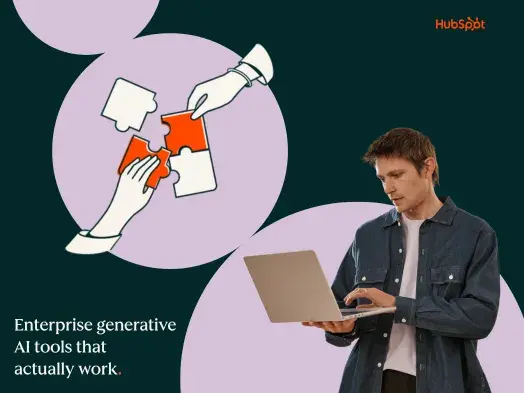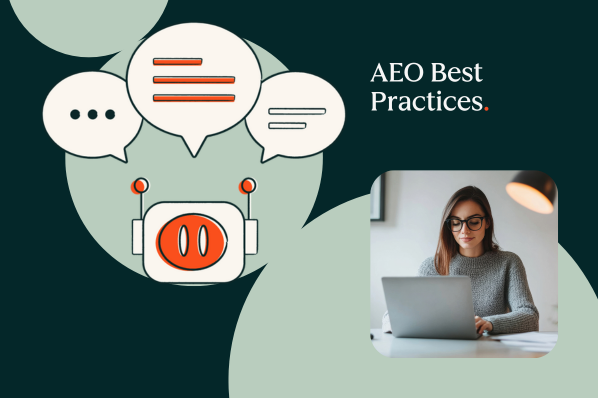ChatGPT runs on data and context. Learn how to train ChatGPT well, and you can expect it to do a lot of the heavy lifting for you. However, if you do it wrong, you’ll end up with the same generic outputs.
In this post, I’ll walk you through my training process, actual prompts I use across my clients, and how you can tweak them for your workflow. You’ll also see the limitations I still run into and how I work around them.
Table of Contents
- ChatGPT for Marketing: Key Advantages and Limitations to Know
- 5 Amazing Marketing Use Cases for ChatGPT
- 5 Actionable Tips for Training ChatGPT for Marketing
- 10 Marketing Prompts to Help Train ChatGPT
- How to Train Your ChatGPT With Custom Data on Mac
ChatGPT for Marketing: Key Advantages and Limitations to Know
I’ve been using ChatGPT every day since early 2024. From writing ad copy and email subject lines to brainstorming campaign angles, it’s become a reliable way to get unstuck and speed up the grunt work.
That said, it’s not perfect. Some things work brilliantly, while others still require a workaround (or just plain human effort). Here’s what I’ve learned after using it in real campaigns, across multiple clients, for over a year.
Advantages of ChatGPT in Marketing
Over time, ChatGPT has become part of how I think through and execute campaigns. It’s not doing the work for me, but it helps me get more done, especially when I’m switching between brands or juggling different formats.
1. Speed Up Creativity
Whenever I need headline options, blog angles, or email copy ideas, ChatGPT helps me skip the blank-page stage. I usually start by giving it a short message about the brand’s voice and the goal of the task. With GPT-5 (available in the Pro plan), the ideas are more relevant and the tone is much sharper compared to older versions.
It doesn’t always get it right on the first try, but it’s quick enough that I can test two or three variations in a few minutes and move forward with something workable.
2. Cost-Effective Assistant
The free version is fine for quick tasks. But if you’re juggling multiple clients like I am, the $20/month Plus plan (or $60/month Pro with GPT-5 access) pays for itself almost instantly.
I know some people call it a writing assistant, but it works better when I give it a specific role. For example, I’ve built a custom GPT that acts as a junior content strategist. I trained it on sample blog outlines, voice rules, and structure preferences. Now I can ask it to plan a content calendar or suggest headlines based on a campaign idea.

This is available in the Pro version under “Explore GPTs.” Using custom GPTs has made a big difference for tasks I need to repeat often.
3. Round-the-Clock Availability
I typically use ChatGPT as a handy intern I can call on at any time of the day. For instance, if my client is asking for copy variations for a social post, I can quickly ask GPT to spin up five different versions of the post. The best part is that the feedback cycle is instantaneous, which means I can get to the end result faster. I also like its “Tasks” feature, which allows you to set reminders and to-dos directly in a chat.
4. Ease of Integration With Other Tools
With Notion, Zapier, or even custom internal tools, it’s simple to integrate ChatGPT into your workflow. I’ve connected ChatGPT to a few tools I already use, mainly Notion and Zapier. For example, I set up a Notion button that sends topic outlines to GPT and returns a rough draft. In Zapier, I’ve used it to write auto-replies to leads based on how they fill out a form.
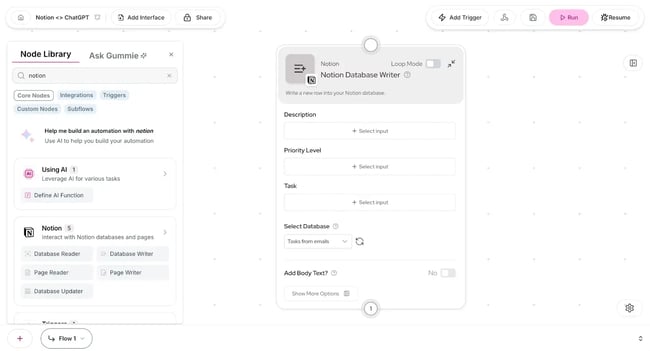
Limitations of ChatGPT in Marketing
While ChatGPT is a helpful tool, it still needs oversight. Here are some of the limitations you should be aware of.
1. Prone to Poor Quality and Inaccurate Output
With ChatGPT, you have to double-check everything. ChatGPT can sound confident while being completely wrong. I’ve had it invent data, misquote stats, or my personal favorite: swap in a client’s competitor name in a headline.
My advice is to treat all GPT outputs as base drafts. I double-check data, search for the original source, or ask ChatGPT to cite where it found something. If it can’t, I don’t use it.
2. Limited Contextual Understanding and Bias
Unless you feed ChatGPT the same instructions in every chat, it forgets your preferences fast. I created one for blog content where I pre-loaded tone rules, sample intros, and formatting preferences. Now I don’t have to remember it every time, and it’s much faster to get to a usable draft. You can also set up a custom GPT.
But if you’re starting fresh, you’ll still need to re-share your tone, goals, and context each time. It’s not a “set it and forget it” tool (yet).
3. No Knowledge of Brand Identity
Even with clear instructions and examples, the first draft generated by GPT usually feels slightly “off.” Structure might be fine, but the tone often needs tweaking. I’ve found the trick is to use ChatGPT for the first draft, then spend a few minutes editing so it sounds natural and on-brand.
Pro tip: I usually write or paste one high-quality sample from past work and tell it to match the voice closely. This gets it closer to the brand voice than just describing the tone in words.
4. Technical Glitches
There are days when ChatGPT just doesn’t work, usually during updates or heavy demand. One outage in late 2024 lasted almost two hours, right in the middle of a campaign push. If you’re relying on it for deadlines, always keep your key prompts saved somewhere else as a backup so you can reuse them quickly in other tools. I use Claude as a backup, just in case I need to get something done while ChatGPT is down.
5 Amazing Marketing Use Cases for ChatGPT
Before we get into how to train ChatGPT, let’s see where it actually fits into real marketing use cases. ChatGPT can streamline a lot of things, but I’ve found these five use cases are where it really shines.
1. In-Depth Market Research
ChatGPT helps speed up the early-stage research process. If I’m working on a new niche, I usually start by asking:
“Give me an overview of [industry] in 2025. Focus on emerging trends, challenges, and buying behaviors.”

I also like to build on the GPT response with questions like:
- “What tools are commonly used by content marketers in this space?”
- “What would be key objections for this type of buyer?”
- “Summarize recent shifts in the [industry].”
The goal isn’t to copy-paste insights, but to narrow down my angle before I start with primary research. For example, I’ll use the intel to shape my blog outline, identify what not to cover (because everyone already has), or pinpoint where to add quotes and stats.
2. Find Ideas to Create Customer Surveys
All successful marketing campaigns have one thing in common: listening to customers.
You have to stay on top of customer expectations and preferences, whether you’re launching a new product, tweaking messaging, or just figuring out why a page isn’t converting.
I usually turn to ChatGPT when I need help shaping a quick feedback form. For instance, if I’m auditing a funnel, I’ll ask:
“Suggest [number] survey questions to ask [target audience] about how they consume [type of content]. Include a mix of open-ended and multiple-choice.”
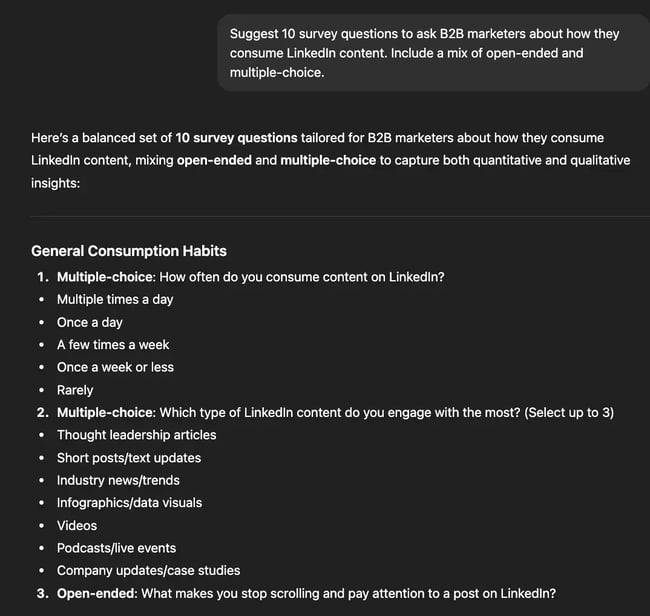
I’ve used ChatGPT to generate pre-launch surveys, post-webinar feedback forms, and even onboarding questions for newsletter readers.
3. Create Blog Outlines and Edit Drafts
As a writer, this is one of my go-to workflows. I feed ChatGPT a topic, the target audience, and any constraints (SEO keywords, internal links, etc.), then ask:
“Create a detailed outline on the [topic]. Add a compelling title, bullet points within each section to explain what to include in these sections, and heading suggestions.”

Once I have a draft, I’ll often paste it back in with a prompt like:
“Tighten this blog for clarity and flow. Keep it human, avoid repetition, and fix any passive voice.”
Using this workflow, I can easily generate drafts that are 70% there.
4. Generate Copy for Emails and Social Media
I use ChatGPT regularly for subject lines, email intros, and social hooks. If I’m promoting a product or event, I’ll ask:
“Write three email subject lines and preview texts promoting a free webinar on [topic]. Keep them short, curiosity-driven, and avoid spammy language.”
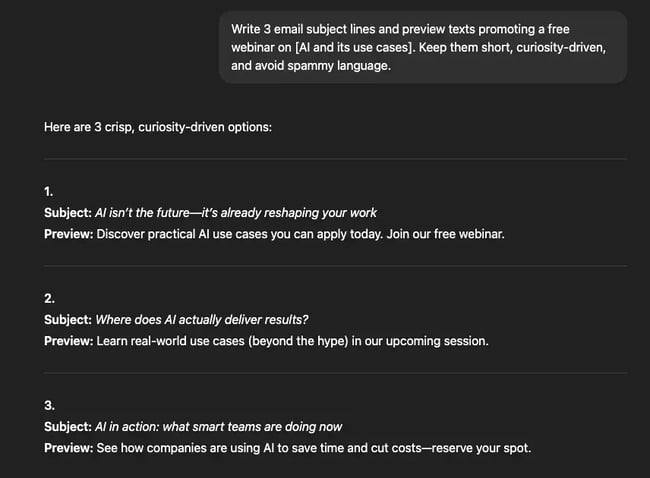
Similarly, for LinkedIn, I’d say something like:
“Write five posts based on this blog according to what works well on LinkedIn. Keep the tone conversational and tailored to the LinkedIn audience.”
This prompt extracts the most relevant information from your blog in seconds and formats it for LinkedIn.
5. Repurposing Content for Different Channels
After publishing a blog or case study, I’ll use prompts like:
“Turn this blog into:
– 2 LinkedIn posts
– 1 Instagram caption
– 1 newsletter blurb
Keep the tone friendly and platform-appropriate.”
This is especially helpful when you want to stay consistent across channels but don’t want to repeat the exact same message. This prompt saves me hours each week on repackaging content for different formats.
5 Actionable Tips for Training ChatGPT for Marketing
Now that we’ve covered the basics of how you can use ChatGPT for marketing, it’s time to get down to business: how to train ChatGPT. While there are tons of prompts to inspire your training efforts, I’ve curated my top five tips for training the tool for customized outputs.
1. Document your brand guidelines.
Before using ChatGPT for any writing task, I always share the brand’s tone, voice, and preferred structure. I keep a short paragraph ready with all the key details. It includes things like how formal the tone should be, whether we use contractions, if we use emojis or not, and what kind of phrases we avoid.
I either paste this at the start of my prompt or add it to the Custom Instructions tab. That way, every reply already sounds closer to what I need. The setup takes a few minutes, but it saves time with every prompt after that.
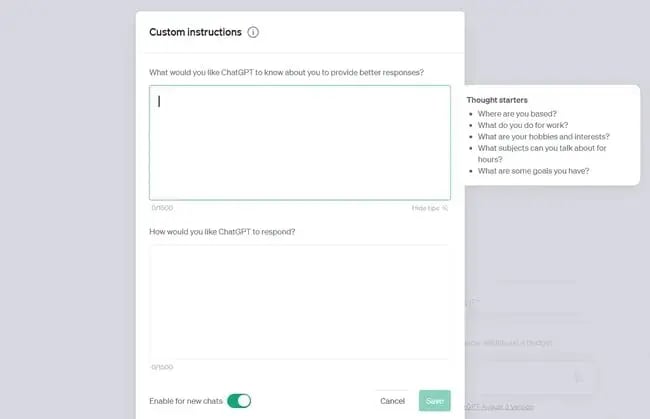
2. Templatize your instruction prompts.
Using templates can drastically speed up your content creation process. I use them when I’ve to repeat the same task across clients, especially if each of them have different requirements. Custom GPTs can also work for this use case, but I’ve found that the output with well-defined templated prompts is far better. You can also use these templates in SOPs for your team members.
Each template includes three things: the role ChatGPT should play, the task it needs to complete, and the output format I want.
3. Share insights about your target audience.
ChatGPT writes better when it knows who you’re writing for. I usually include two to three lines about the audience before asking it to write something. I mention things like what they care about, what stage of awareness they’re in, and what kind of tone works best for them.
If I’m writing for founders, I say things like, “They are busy, already know the basics, and want clear, practical insights.” That small addition usually makes the output sharper and more focused.
4. Simulate marketing scenarios and use real examples.
Instead of asking for “10 hooks for a product,” I try to be more specific. I give ChatGPT a real campaign scenario like, “We’re launching a new AI tool to help freelancers track their time. Give me five hooks for a carousel post that explains how it works.”
Like I mentioned earlier, I also add one or two examples of what’s worked in the past as context. This makes a big difference in the kind of responses it gives.
5. Refine your training based on testing and feedback.
You can regularly review the effectiveness of your training by answering a few questions, like:
- Is ChatGPT producing relevant ideas and writing brand-aligned content?
- Does your ChatGPT-generated content/copy match your brand’s tone of voice?
- Are customers enjoying the campaigns created with AI’s assistance?
- Has there been any decline in the quality graph?
The important part is not to expect perfect results on the first try. I usually run the same prompt a few times with slight variations, pick the best one, and then tweak it manually. I also ask team members to point out what feels off.
10 Marketing Prompts to Help Train ChatGPT
If you’ve already set up your brand tone, created reusable templates, and added context through examples, these prompts are where it all starts to come together. They’re designed to help marketers move faster without compromising on quality. Each prompt is something I’ve used myself or adapted from real client work.
1. Create Buyer Personas
Prompt
“You are a senior product marketer. Based on the product description below, create three buyer personas. For each persona, include demographics, job title, company size, daily challenges, purchase triggers, and what kind of messaging resonates with them.”
[Paste product description here]
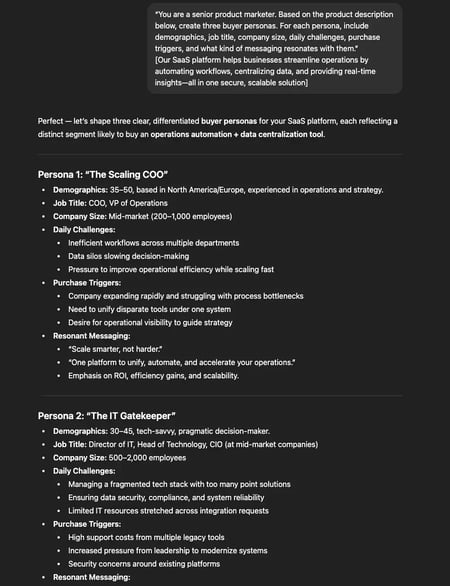
Why This Helps
Instead of guessing who you’re writing for, use this prompt to create realistic personas to guide messaging. It works especially well when starting a new client project or entering a new vertical.
2. Identify Pain Points
Prompt
“You are a customer researcher. Based on this audience segment [describe audience], list the top five pain points they face related to [problem]. Write as if they’re sharing frustrations with a peer.”
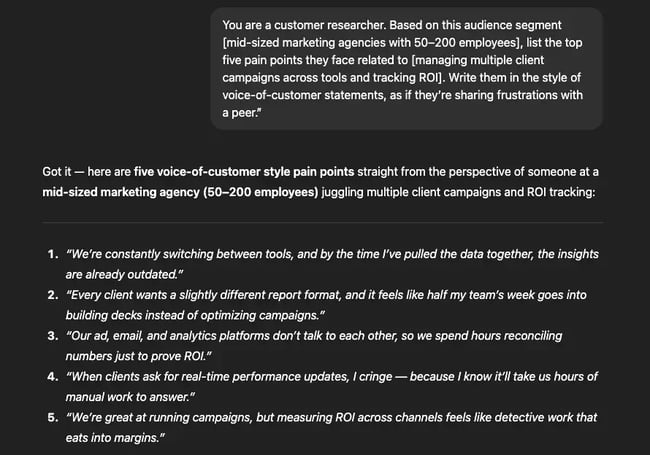
Why This Helps
Pain points written in everyday language are gold for copy. I use this when writing ads, landing pages, or lead magnets. You can also reuse these lines directly in hooks or subject lines.
3. Generate Snappy Ideas
Prompt
“You’re a creative strategist. I’m creating a carousel post on LinkedIn about [topic]. Suggest 10 hook ideas to make people stop scrolling. Keep each hook under 15 words.”

Why This Helps
Great for when you're stuck staring at a blank screen. These hooks can often become headlines, intro lines, or even slide one of a carousel.
4. Repurpose Long-Form Content
Prompt
“Repurpose this blog post into 10 LinkedIn posts. Vary the format: story-driven, data-focused, question-based, controversial take, how-to. Each post should have a key takeaway for the [target audience].”
[Paste blog content]
For this prompt, I also like to include 2-3 examples of high-performing LinkedIn posts (either my own or a competitor’s post) so ChatGPT understands the style I want.
Why This Helps
If you’re managing multiple channels, this prompt helps you repackage information while keeping it fresh. I use it after finalizing any blog post to build a week’s worth of supporting LinkedIn content.
5. Create Short-Form Captions
Prompt
“You are a social media copywriter. Write 5 Instagram captions for [product or offer]. Each caption should include a short hook, a clear benefit, and a soft CTA. Keep the tone friendly and the length under 150 characters.”

Why This Helps
Useful when you need multiple variations for A/B testing or to match different creatives. You can also add ‘add emojis’ or ‘no emojis’ depending on the brand.
6. Write Title Tags and Meta Descriptions
Prompt
“Based on the blog post below, write 3 SEO-friendly title tags (under 60 characters) and three meta descriptions (under 150 characters) using the keyword [insert keyword]. Make them clear, not clickbait, and match the tone of the blog.”
[Paste blog content]
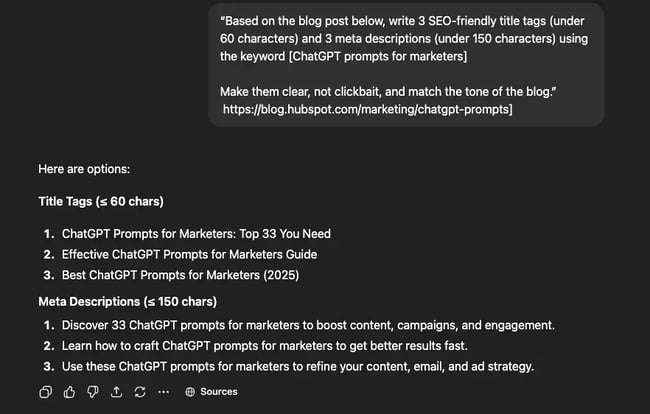
Why This Helps
Even if I rewrite these manually later, having options up front saves time during uploads. It’s especially handy when scheduling multiple posts in one go.
7. Brainstorm Campaign Ideas
Prompt
“You’re a campaign strategist. I’m planning a marketing push for [product or launch type] targeted at [audience]. Suggest five creative campaign ideas with platform recommendation, messaging angle, and format. Add a one-line goal for each.”
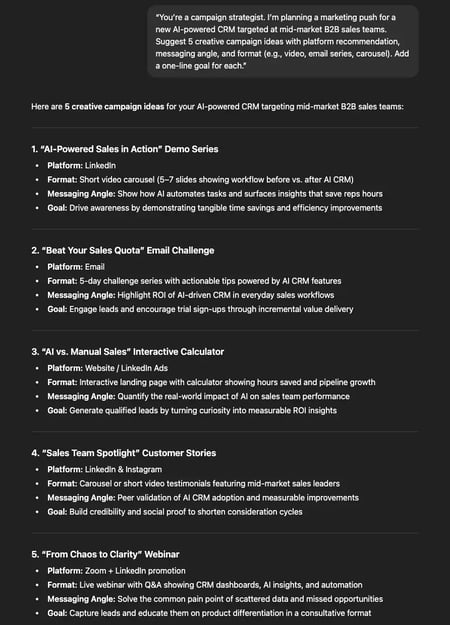
Why This Helps
While this is helpful during internal planning, I’ve also used this prompt in client meetings to co-create ideas live and spark real discussion.
8. Curate Relevant Sources or Stats
Prompt
“You are a content strategist. I’m writing a blog post or campaign about [topic]. Find five credible and recent (from 2023 onwards) statistics, reports, or news updates that would support the content. For each one, include a one-line summary and the source link. Prioritize data points marketers or business leaders would care about.”
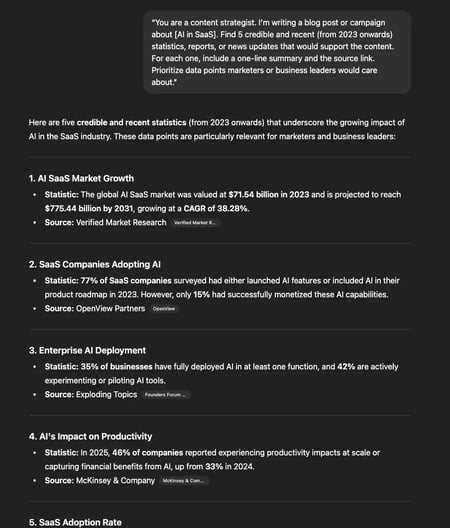
Why This Helps
This prompt gives you a starting point for research-heavy content. While I still verify every stat myself, the summaries help speed up the research.
9. Improve Drafted Content
Prompt
“You are a senior copy editor. Review the content below and make it easier to read for busy professionals. Shorten long sentences, break up dense sections, improve flow, and keep a conversational tone. Use formatting suggestions like line breaks or headers if needed. Don’t rewrite the meaning, just improve clarity.”
[Paste content here]

Why This Helps
I use this after writing my first draft. The edits aren’t always perfect, but they surface clunky phrasing or wordy sections quickly.
10. Create Light, Relatable Content (Memes or One-Liners)
Prompt
“You are a social media strategist for a marketing agency. Write five short content ideas that use humor or relatability to connect with marketers. Use formats like tweet-style posts, memes, or one-liners. The goal is to increase engagement while still aligning with our tone: casual, self-aware, and not cringey. Avoid overused jokes.”
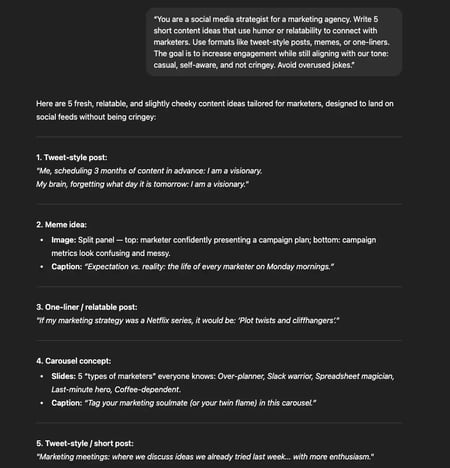
Why This Helps
Great for filler posts between bigger campaigns or just adding personality to your feed. I use these when there are no major events for the company.
How to Train Your ChatGPT With Custom Data on Mac
Want to use ChatGPT’s powerful capabilities inside your app? You can directly train the OpenAI API with custom data and fine-tune it. This guide walks through how to train GPT with Python on a Mac.
Step 1. Install Python.
Open Terminal and check if Python is already installed:
python3 --version
If not installed, download it from python.org/downloads.

Step 2. Upgrade PIP.
PIP is Python’s package installer. Keep it up to date for smooth installs:
python3 -m pip install --upgrade pip
Step 3. Install the essential libraries.
Install the required libraries using:
python3 -m pip install openai pandas tiktoken
- openai: Lets you send prompts to the API.
- pandas: Helps handle CSVs or structured text.
- tiktoken: Helps estimate token usage, so your request doesn’t get cut off.
Note on token limits: GPT-4 has a token limit (e.g., ~128K for GPT-4-turbo). If you send too much data, the request will fail. Use tiktoken to check token usage or trim your content down before sending.
Step 4. Generate your OpenAI key.
Visit OpenAI API Keys and generate a new key.
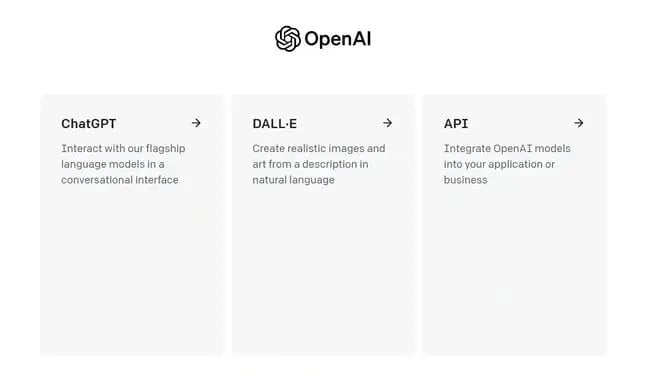
Once you’re in, navigate to the top-right corner of your screen and click on Personal to open a drop-down menu with these options.
Here, you have to click on View API keys.
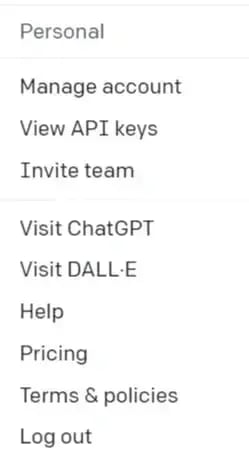
Click on Create a new secret key to generate a new API key and give it a name.
Then, you’ll get a key. Copy and paste it into a code editor.
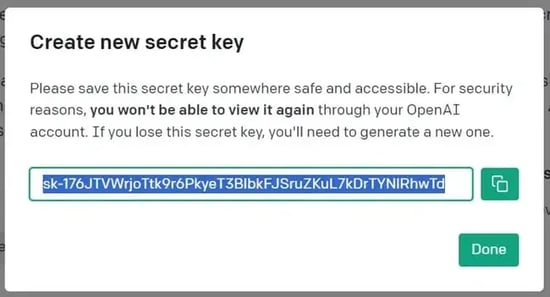
Step 5. Prepare your custom data.
This could be:
- Blog content.
- Customer FAQs.
- Product documentation.
- Brand voice guidelines.
Save it in a .csv, .txt, or .json file. Keep only what’s relevant and remove anything outdated.
Step 6. Create the script.
Below is a simple Python script that loads your data and sends it to ChatGPT with a custom prompt.
import openai
import pandas as pd
openai.api_key = “your_api_key_here”
# Load content (check path and file format)
try:
df = pd.read_csv(“your_data.csv”)
except FileNotFoundError:
print(“File not found. Check your file path.”)
exit()
context = “\n\n”.join(df[“content”].dropna().tolist())
# Send data as part of prompt
response = openai.ChatCompletion.create(
model=“gpt-4”,
messages=[
{"role": "system", "content": "You are a helpful marketing assistant. Use the following context to guide your answers."},
{"role": "user", "content": context + "\n\nNow answer this: What are five blog topics we could cover this month?"}
]
)
print(response[‘choices’][0][‘message’][‘content’])
Note: This is a one-time interaction. The model doesn’t “remember” this context in future chats. Each time you run it, you’ll need to provide context again unless you're building a custom GPT.
Step 7. Run the script.
Save the file as chatgpt_custom.py and run it from Terminal:
python3 chatgpt_custom.py
You should see the output printed right below. If not, check for any error messages — most are related to file paths, key issues, or token limits.
Training ChatGPT for Marketing
ChatGPT has become a regular part of my workflow. It’s not perfect, but with the right setup, it saves me a lot of time and mental load. Training it well has made the biggest difference. From documenting brand voice to uploading reference files, every small tweak helped me get better, more usable results. The more specific I am, the more useful the output becomes.
So, if you’re struggling with getting the right output from ChatGPT, try the prompts in this guide. Time to start training.
Editor's note: This post was originally published in October 2023 and has been updated for comprehensiveness.
Artificial Intelligence

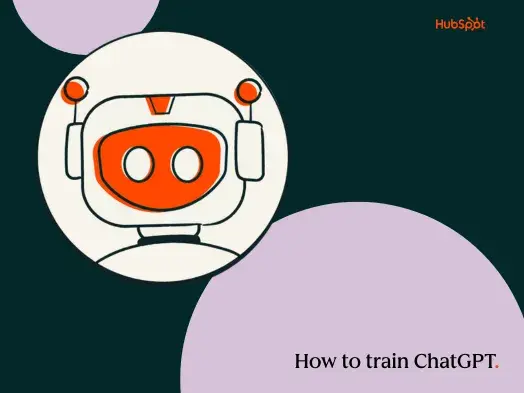
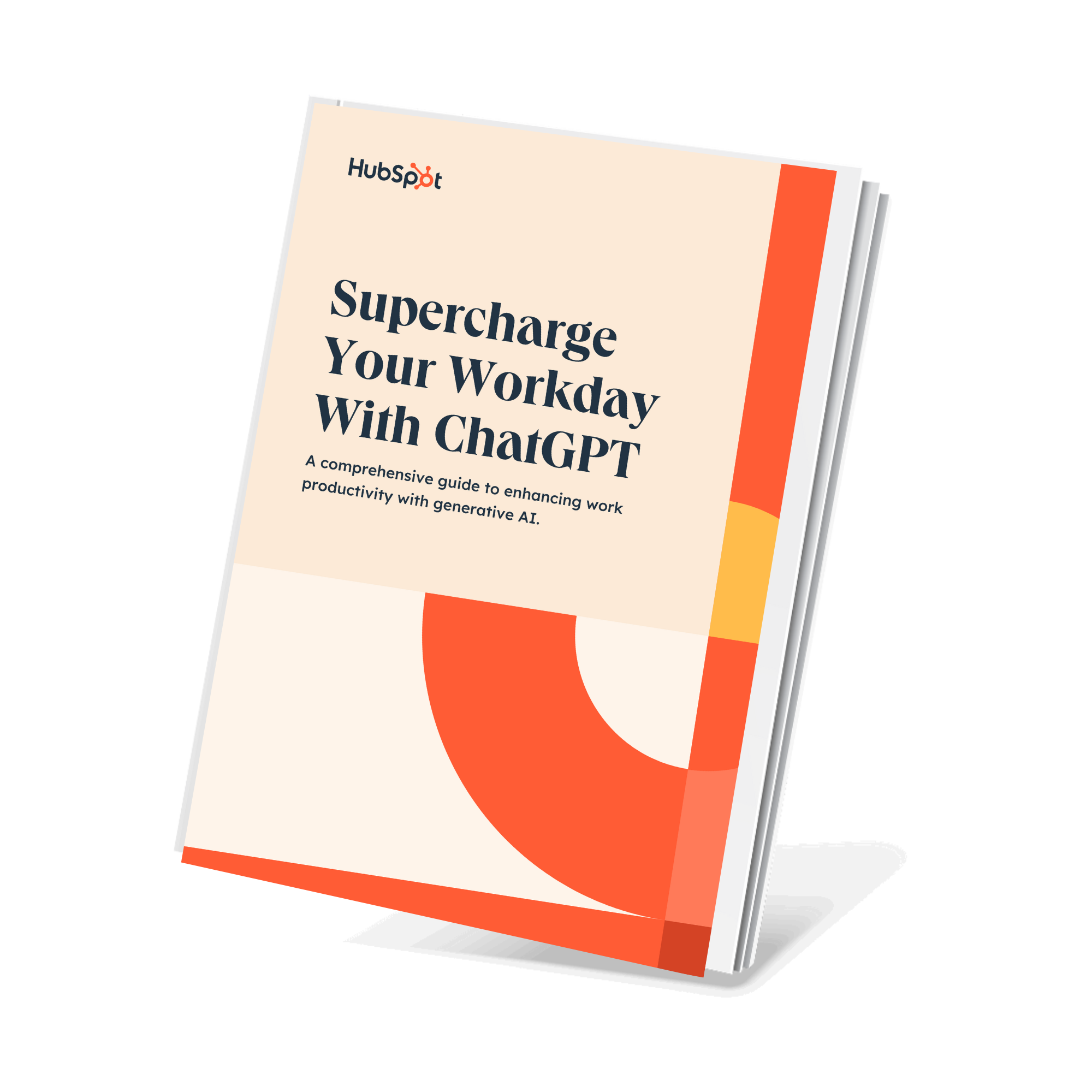

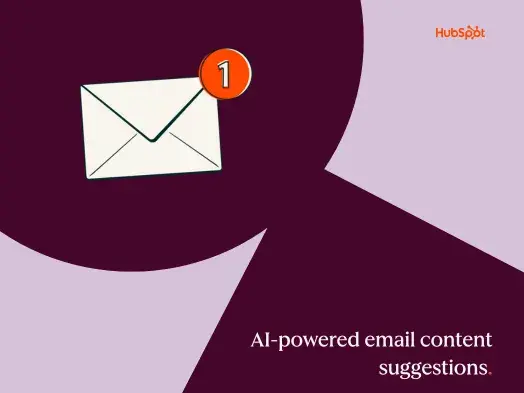

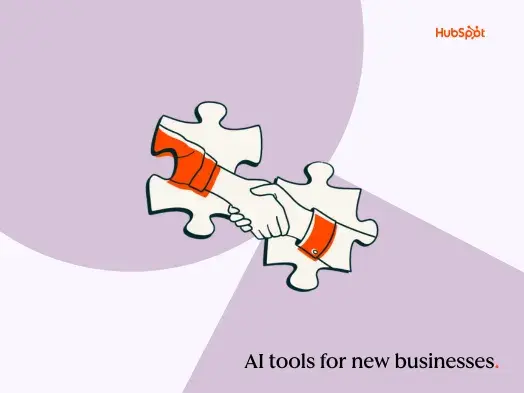
![AI email subject lines that drive 3x more revenue and actually convert [+ exclusive insights]](https://53.fs1.hubspotusercontent-na1.net/hubfs/53/ai-email-optimization-1-20251014-4500151-1.webp)
